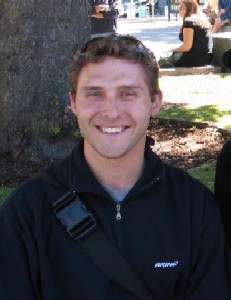|
 Thomas
Oberst Thomas
Oberst
2004
- 2005 CSIP Fellow
Research
Interest:
Physics and Astronomy
I entered Cornell in fall of 2002 as a Ph.D.
student in the Department of Physics, but through chance
and good-fortune found my way over to the Astronomy Department,
where I plan to stay and complete my dissertation research.
My research involves the development of instrumentation
for detecting infrared light in the star-forming regions
of galaxies. Or, if you like, Observational Infrared Astronomy.
By mapping galaxies in the infrared, we are aiming to answer
such questions as “How do stars form?”, “What
triggers star formation?”, In what environment are
stars formed?”, and “How do stars change that
environment?”. We spend most of our time working with
our hands building, developing, and testing hardware, electronics,
and instrumentation right here in the Space Sciences Building
on Cornell’s campus. The culmination of that work
comes once or twice a year when we travel with our instruments
to the sites of major telescopes (most recently Mauna Kea
in Hawaii and the South Pole) and look at galaxies. To accomplish
our goals we regularly incorporate principles from a wide
range of scientific fields, including: mechanics, optics,
atomic physics, low temperature physics and cryogenics,
vacuum technology, electronics, chemistry, atmospheric science,
computer science, and of course astronomy.
My goal as a CSIP fellow is to show students that science
can be enjoyable and inspirational. The first step is to
get students to start asking questions about the world around
them, such as “What is light?”, “How big
are atoms?”, or “Where do magnetic fields come
from?”. Once motivated, these questions can be explored
by having the students conduct basic physics experiments
in the classroom (depending on what equipment is available).
Alternatively, in many cases deep physical questions can
be probed using a technique developed by Albert Einstein
called the thought experiment---a method of scientific inquiry
that uses reasoning, logic, and intuition to answer new
questions based on what we already know about the principles
of nature. Thought experiments are especially useful when
the objects of study can’t be readily brought into
the classroom: for example, when questioning the processes
that occur in stars and galaxies!
|

